Sabra Health Care REIT Bundle
How is Sabra Health Care REIT Navigating the Healthcare Real Estate Landscape?
Sabra Health Care REIT, a leading Sabra Health Care REIT SWOT Analysis, recently demonstrated impressive financial results, with Q1 2025 earnings meeting expectations and revenue reaching $183.54 million. This performance propelled a 3.27% increase in its stock price, signaling strong investor confidence. Positioned strategically within the healthcare real estate sector, Sabra is poised to capitalize on favorable demographic trends, especially the aging U.S. population. This makes understanding its operational model critical for investors.
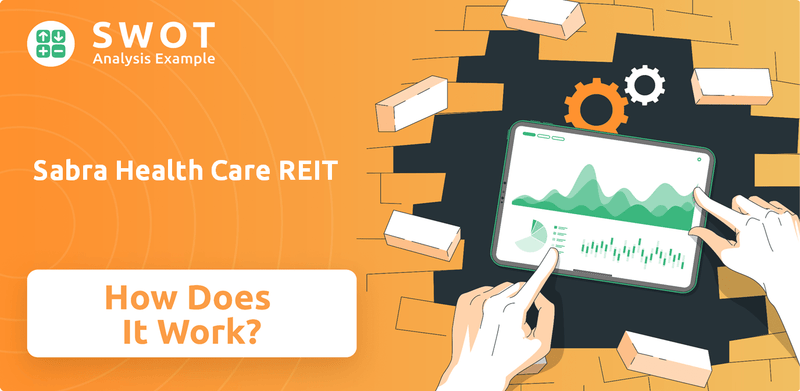
With a market capitalization of $4.23 billion and a consistent dividend yield of 6.8% as of May 5, 2025, Sabra Health Care REIT presents a compelling case for investors. Its diversified portfolio, encompassing 399 investments across 59 relationships, and a weighted average remaining lease term of 7 years, further highlights its stability. This examination will explore how this Healthcare REIT operates, generates revenue, and manages its portfolio of healthcare properties, particularly in senior housing and skilled nursing facilities, providing valuable insights for those considering an investment or seeking to understand the Real estate investment trust market.
What Are the Key Operations Driving Sabra Health Care REIT’s Success?
Sabra Health Care REIT is a self-administered, self-managed Real Estate Investment Trust (REIT) that focuses on healthcare properties. It operates primarily in the United States and Canada, acquiring, financing, and owning real estate leased to third-party healthcare operators. Their portfolio includes a variety of healthcare facilities, ensuring a diversified approach to the healthcare real estate market.
The company's core business revolves around owning and leasing healthcare properties, generating income through rental payments from operators. This structure allows Sabra to focus on real estate investments while the operators manage the healthcare services. This strategy offers investors a way to participate in the healthcare sector through a stable, income-generating asset.
Sabra's value proposition lies in its disciplined investment strategy and diverse portfolio. This approach, combined with long-term triple-net lease structures, provides a competitive edge by offering stable income and lower risk for investors. The company's focus on earnings growth and asset appreciation, along with a strong balance sheet, is designed to provide long-term value.
As of March 31, 2025, skilled nursing facilities made up the largest portion of Sabra's portfolio. Senior housing-managed properties, behavioral health facilities, and senior housing-leased properties also contribute significantly to the portfolio's diversification. This diversification helps to mitigate risk and provides exposure to various healthcare segments.
Sabra identifies investment opportunities, focusing on needs-based healthcare facilities in markets with favorable demographics. They build strong relationships with regional operators. The company supports its operators through redevelopment, expansion, and strategic development, offering flexible capital solutions.
The primary source of revenue for Sabra Health Care REIT comes from rental income derived from its healthcare properties. These properties are leased to third-party operators, who pay rent based on the terms of the lease agreements. The company's financial performance is directly tied to the occupancy rates and operational success of these leased properties.
Sabra's investment strategy prioritizes earnings growth and asset appreciation. They maintain a strong balance sheet and liquidity to support their operations. This strategy is designed to provide stable income and lower risk for investors. For more insights, consider exploring the Competitors Landscape of Sabra Health Care REIT.
As of March 31, 2025, skilled nursing facilities accounted for 51.6% of Sabra's portfolio, highlighting the importance of this segment. Senior housing-managed properties represented 19.6%, behavioral health facilities 13.5%, and senior housing-leased properties 10.6%. The company's focus on a diversified portfolio helps to mitigate risks associated with specific healthcare sectors.
- The company's focus on skilled nursing facilities remains a core component of its portfolio.
- Senior housing and behavioral health facilities add to the diversification.
- Long-term triple-net lease structures provide stable income.
- The company's financial performance is closely tied to the operational success of its leased properties.
Sabra Health Care REIT SWOT Analysis
- Complete SWOT Breakdown
- Fully Customizable
- Editable in Excel & Word
- Professional Formatting
- Investor-Ready Format
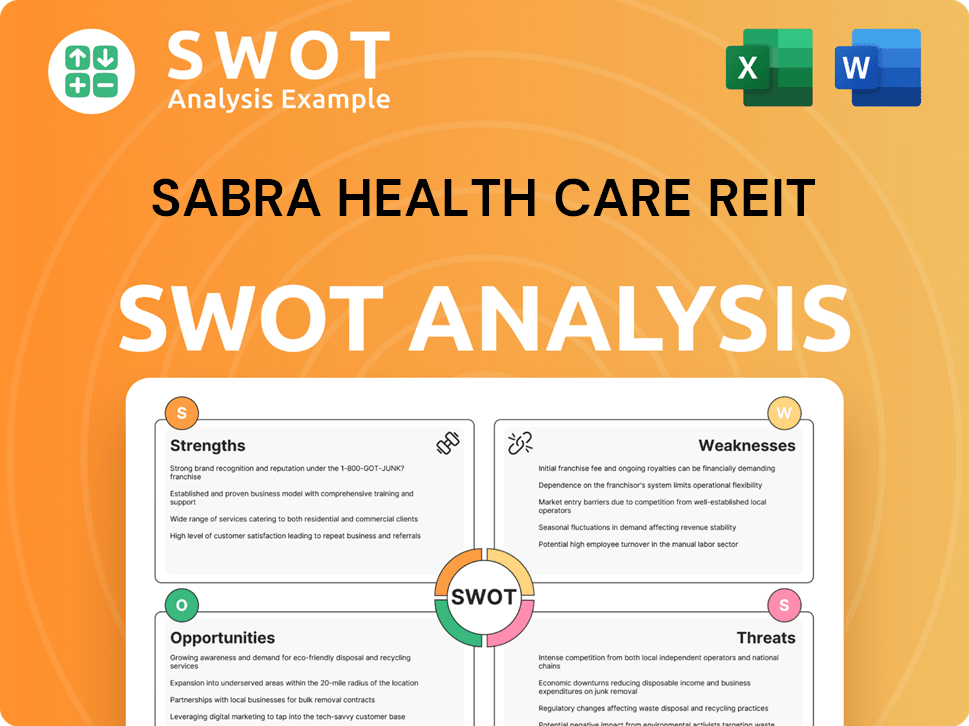
How Does Sabra Health Care REIT Make Money?
Sabra Health Care REIT (a Healthcare REIT) primarily generates revenue through its healthcare properties portfolio. Their revenue streams include rental income from skilled nursing facilities, senior housing, and other healthcare properties. Additionally, the company provides mortgage and other loans to operators, further diversifying its income sources.
The company's financial performance highlights its revenue generation capabilities. In Q1 2025, Sabra reported total revenue of $183.54 million, an increase from $166.75 million in Q1 2024. For the fiscal year ending December 31, 2024, total revenues were $1,111 million, reflecting growth in rental income and interest.
The lease model is a critical aspect of how Sabra Health Care REIT operates within the healthcare real estate sector. This model offers providers financial flexibility, enabling them to focus capital on patient care rather than property ownership. Long-term lease agreements provide Sabra with stable income and reduce overall risk.
Sabra's monetization strategies are multifaceted, designed to maximize returns and maintain portfolio quality. These strategies include a focus on the Senior Housing Operating Portfolio (SHOP) and capital recycling initiatives.
- Senior Housing Operating Portfolio (SHOP) Performance: The SHOP portfolio has shown strong performance, with same-store cash Net Operating Income (NOI) increasing by 16.9% year-over-year in Q1 2025. This growth is driven by increased occupancy and revenue per occupied room (RevPOR).
- Capital Recycling: Sabra engages in strategic asset sales to improve portfolio quality and fund new investments. This approach helps optimize the company's asset base and reinvest capital in higher-yielding opportunities.
- Lease Agreements: Long-term lease agreements with healthcare providers provide a stable and predictable revenue stream. The lease model accounts for 65.10% of the market share in 2024, demonstrating its importance in the healthcare real estate sector.
Sabra Health Care REIT PESTLE Analysis
- Covers All 6 PESTLE Categories
- No Research Needed – Save Hours of Work
- Built by Experts, Trusted by Consultants
- Instant Download, Ready to Use
- 100% Editable, Fully Customizable
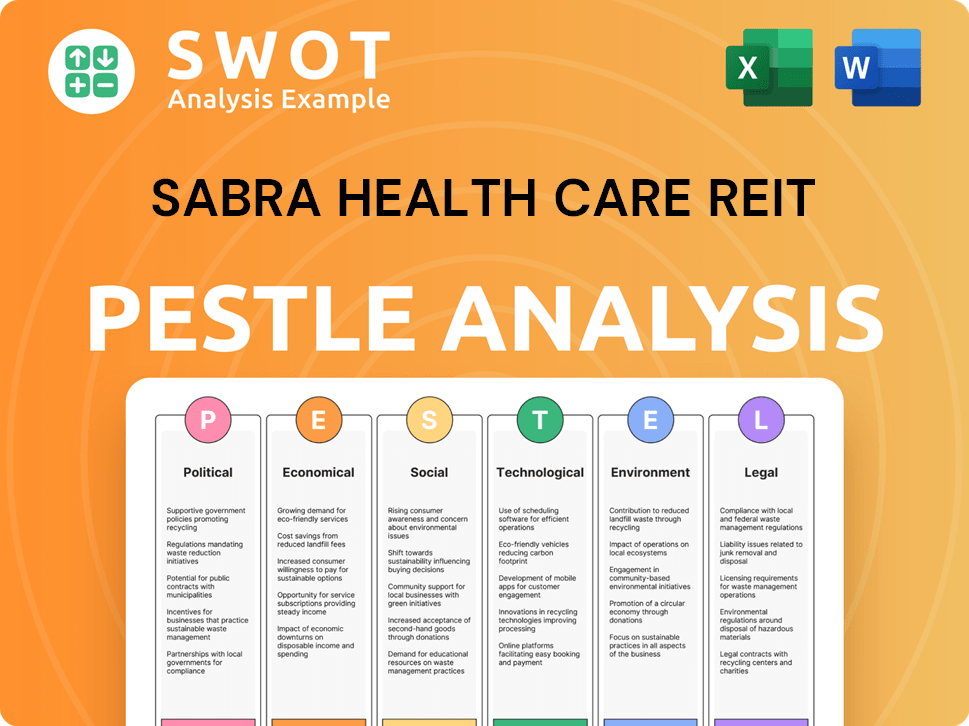
Which Strategic Decisions Have Shaped Sabra Health Care REIT’s Business Model?
Sabra Health Care REIT has strategically positioned itself in the healthcare real estate sector through significant moves. A key focus has been shifting investments toward private-pay senior housing and away from skilled nursing facilities. This strategy aims to enhance revenue stability and capitalize on growth prospects within the healthcare REIT market.
The company's portfolio adjustments include acquisitions, dispositions, and operator transitions, all designed to improve asset quality and financial performance. These actions have been crucial in navigating the evolving landscape of healthcare properties. The company has also demonstrated resilience in overcoming operational challenges, including those brought on by the COVID-19 pandemic.
Sabra Health Care REIT continues to adapt and evolve its investment strategies to meet the changing demands of the market. For example, in Q1 2025, the company acquired the second phase of its Legacy Living Jasper senior housing campus for $7.8 million, with an initial cash yield of 7.5%. Additionally, the company has been awarded over $200 million of newer vintage senior housing acquisition opportunities expected to close soon.
A major milestone includes the shift in investment focus toward senior housing. The company sold 84 senior living communities in 2023 for $730 million. This strategic move reflects a proactive approach to portfolio optimization and growth.
The company actively repositions its portfolio through acquisitions, dispositions, and operator transitions. In Q1 2025, Sabra acquired the second phase of its Legacy Living Jasper senior housing campus. The company is also utilizing its at-the-market (ATM) equity program.
Sabra Health Care REIT benefits from a diversified portfolio across various geographic locations and property types. The company has a strong balance sheet with approximately $1 billion in liquidity as of March 31, 2025, and 98% of its borrowings are unsecured. An experienced management team and strong relationships with leading healthcare operators also provide an advantage.
The company has shown resilience, with skilled nursing margins returning to pre-pandemic levels. In Q1 2025, the company utilized its ATM equity program to sell up to 4.9 million shares at an average price of $17.32 per share to reduce debt and fund growth. The company continues to adapt to new trends, such as leveraging its at-the-market (ATM) equity program to reduce debt and fund growth.
Sabra Health Care REIT has demonstrated its ability to navigate challenges and adapt to market changes. The company's focus on senior housing and strategic financial management has been key to its performance. For more insights into the company's history and evolution, you can read a Brief History of Sabra Health Care REIT.
- Focus on senior housing.
- Strong balance sheet with approximately $1 billion in liquidity.
- Experienced management team.
- Use of ATM equity program.
Sabra Health Care REIT Business Model Canvas
- Complete 9-Block Business Model Canvas
- Effortlessly Communicate Your Business Strategy
- Investor-Ready BMC Format
- 100% Editable and Customizable
- Clear and Structured Layout
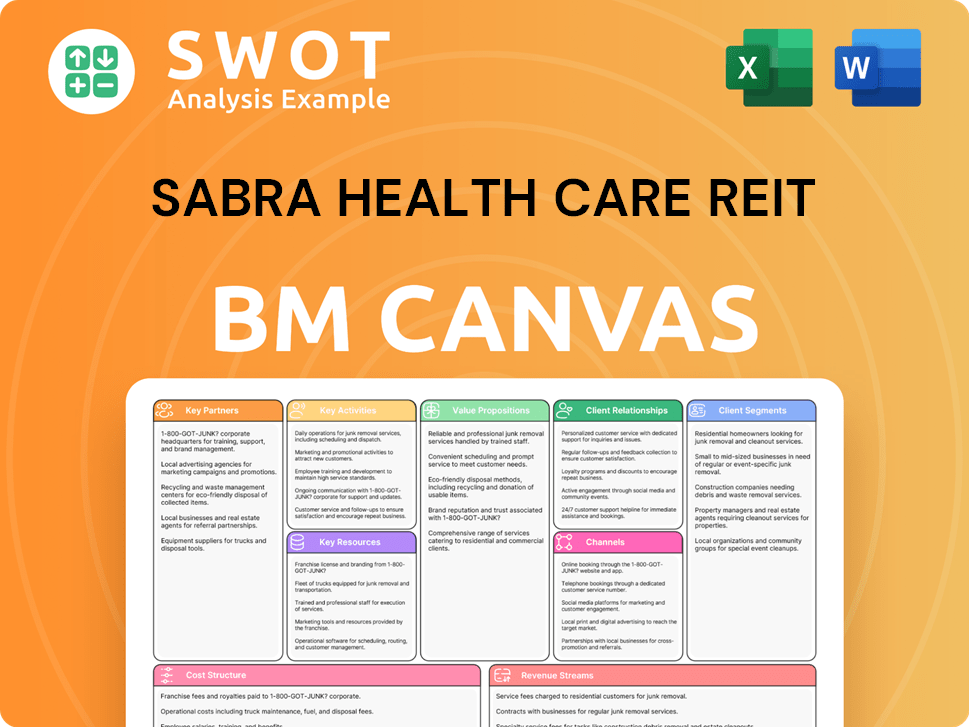
How Is Sabra Health Care REIT Positioning Itself for Continued Success?
The company, a Healthcare REIT, holds a solid position in the healthcare real estate sector. It focuses on needs-based healthcare facilities, including skilled nursing, senior housing, and behavioral health properties. As of March 31, 2025, its portfolio comprises 399 investments across 59 relationships, showing a diversified approach within the Real Estate Investment Trust (REIT) landscape.
However, the company faces various risks, including potential fluctuations in Medicare and Medicaid reimbursement rates, complex regulations, and economic uncertainties. These challenges could impact its financial performance. Despite these risks, the company is actively working to maintain its financial health and adapt to the changing healthcare environment.
The company's portfolio includes a variety of healthcare properties. The EBITDARM coverage ratios for Q1 2025 were: skilled nursing/transitional care at 2.19x, senior housing-leased at 1.41x, and behavioral health/hospitals/other facilities at 3.77x. Occupancy rates are: skilled nursing at 82%, senior housing-leased at 90%, and behavioral health/hospitals/other facilities at 78%.
The company faces risks like changes in Medicare and Medicaid reimbursement, complex healthcare regulations, and economic pressures. The CMS's Minimum Staffing Standards could increase operational costs. Rising interest rates may also affect borrowing costs.
The company reaffirmed its 2025 earnings guidance, expecting low to mid-teens cash NOI growth for its Senior Housing Operating Portfolio (SHOP). It anticipates continued occupancy and RevPOR increases. A proposed Medicare rate increase of 2.8% for fiscal year 2026 is also expected.
The company is focused on portfolio optimization, maintaining a mix of assets well-positioned for future healthcare delivery, and pursuing accretive investments. It aims to maintain balance sheet strength and lower leverage. It is funding accretive investing activity with available liquidity, recycled capital, and proceeds from its at-the-market (ATM) equity program. For more insights, consider reading the Marketing Strategy of Sabra Health Care REIT.
Sabra Health Care REIT Porter's Five Forces Analysis
- Covers All 5 Competitive Forces in Detail
- Structured for Consultants, Students, and Founders
- 100% Editable in Microsoft Word & Excel
- Instant Digital Download – Use Immediately
- Compatible with Mac & PC – Fully Unlocked
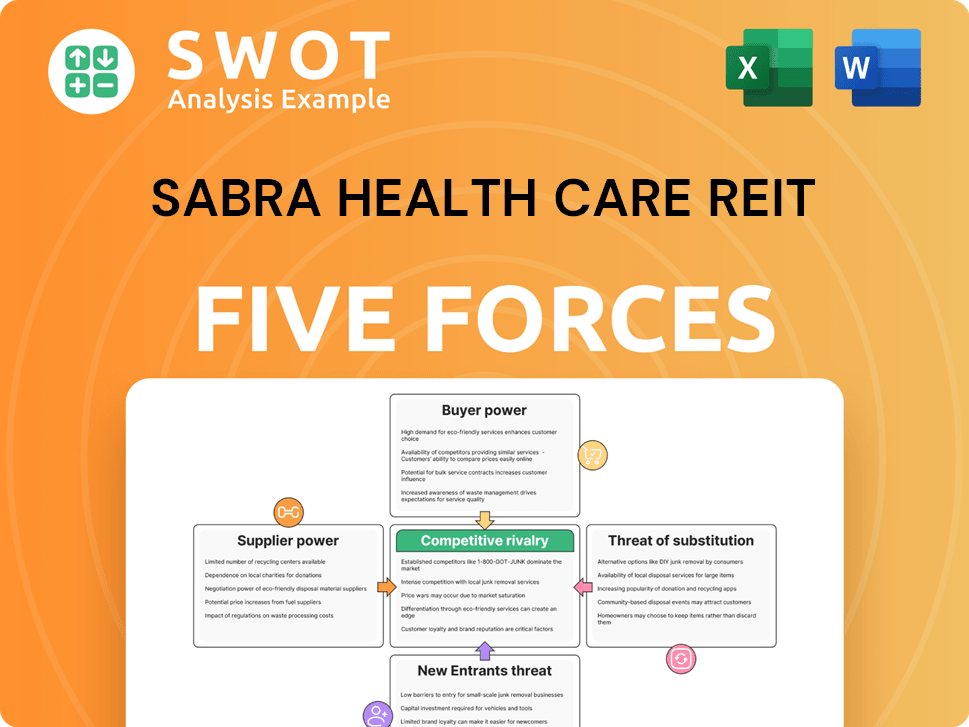
Related Blogs
- What are Mission Vision & Core Values of Sabra Health Care REIT Company?
- What is Competitive Landscape of Sabra Health Care REIT Company?
- What is Growth Strategy and Future Prospects of Sabra Health Care REIT Company?
- What is Sales and Marketing Strategy of Sabra Health Care REIT Company?
- What is Brief History of Sabra Health Care REIT Company?
- Who Owns Sabra Health Care REIT Company?
- What is Customer Demographics and Target Market of Sabra Health Care REIT Company?
Disclaimer
All information, articles, and product details provided on this website are for general informational and educational purposes only. We do not claim any ownership over, nor do we intend to infringe upon, any trademarks, copyrights, logos, brand names, or other intellectual property mentioned or depicted on this site. Such intellectual property remains the property of its respective owners, and any references here are made solely for identification or informational purposes, without implying any affiliation, endorsement, or partnership.
We make no representations or warranties, express or implied, regarding the accuracy, completeness, or suitability of any content or products presented. Nothing on this website should be construed as legal, tax, investment, financial, medical, or other professional advice. In addition, no part of this site—including articles or product references—constitutes a solicitation, recommendation, endorsement, advertisement, or offer to buy or sell any securities, franchises, or other financial instruments, particularly in jurisdictions where such activity would be unlawful.
All content is of a general nature and may not address the specific circumstances of any individual or entity. It is not a substitute for professional advice or services. Any actions you take based on the information provided here are strictly at your own risk. You accept full responsibility for any decisions or outcomes arising from your use of this website and agree to release us from any liability in connection with your use of, or reliance upon, the content or products found herein.